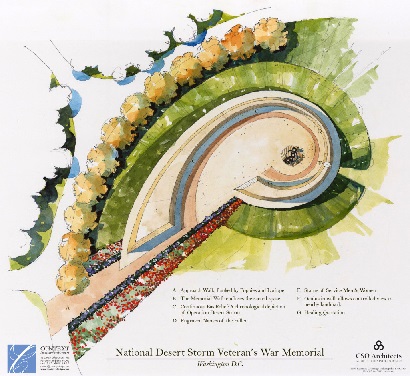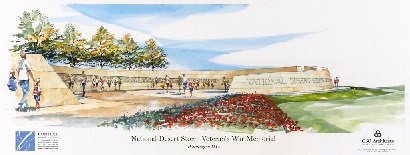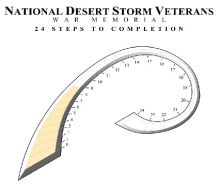The National Desert Storm Veterans War Memorial
We are very proud to present the first set of renderings of the proposed National Desert Storm War Memorial.
The design illustrations shown on this website for the National Desert Storm Veterans War Memorial are the result of a 20-month collaborative effort between the National Desert Storm War Memorial Board of Directors (NDSWMBD), numerous veterans of the war, CSO Architects, Inc., Context Landscape Architecture, and other citizen contributors who were affected by the war. During the process, the NDSWMBD and the Design Team (CSO & Context) sought a great deal of input from many stakeholders and from many veterans of the war. After months of research, surveys, contemplation and Board review sessions, the design team incorporated the Board’s and veterans’ heartfelt thoughts and suggestions directly into the memorial’s design in an effort to create a fitting, meaningful and memorable memorial experience for visitors and for those most affected by the war.
The Desert Storm War Veterans’ Survey
At the outset of the process, a survey was distributed to all Desert Storm veterans in the Board’s database. The survey was also posted on the Nationaldesertstormwarmemorial.org website in order to give an opportunity for all interested veterans to contribute their thoughts and suggestions. As many veteran opinions as possible were sought. The survey asked veterans the following 5 questions:
1. What do you believe was the most historically significant or important accomplishment of the Desert Storm War?
2. What do you believe should be remembered or memorialized for our descendants about this conflict for posterity?
3. What do you believe a National Desert Storm Memorial should look like?
4. What do you believe a National Desert Storm Memorial should symbolize?
5. Please share any other thoughts, stories, letters, photos or artifacts that you wish.
All of the survey responses were tabulated into a Summary Report and then studied carefully by the National Desert Storm War Memorial Board of Directors and by the Design Team. The following (6) ideas were found to be recurring themes that were repeatedly expressed by the surveyed veterans as important and which should be reflected somehow in the memorial’s design:
- The historical significance of so many nations of the free world coming together for a common cause should be a focus of the memorial. The war effort was not a unilateral US effort, but rather a multinational coalition of 34 nations. It was suggested that the design might include a “roll call of nations” or 34 symbolic pillars.
- The memorial’s design should somehow reflect or recreate the desert environment where the war was fought. It might include a rippling sandstone wall or sand dune-like element.
- All of the names of the fallen should be engraved into the memorial. A gold star might be incorporated for each life that was lost.
- The memorial should include a lifelike statue of soldiers wearing protective masks and chemical warfare protective gear.
- The memorial’s design should illustrate the “Left Hook” maneuver that was used to flank the Iraqi forces.
- Bronzes of the campaign ribbons might be incorporated.
The goal of the memorial’s design is to create an educational, meaningful and deeply moving sequential experience for visitors that: 1) educates them about the historical events of the war; 2) identifies each of the coalition countries and illustrates the historical significance of the 34-nation coalition that was united to liberate Kuwait; 3) memorializes all the names of those Americans who sacrificed their lives in the war; 4) reflects the unique environmental and battle conditions experienced by our servicemen and women in this war; 5) leaves visitors with an enduring memory of the historical significance and moral accomplishments of the Desert Storm War.
Toward this end, the National Desert Storm Veterans War Memorial has been designed as an elegantly curved, massive, Kuwaiti limestone wall, which both encloses and envelopes a sacred, somber, inner memorial space. The curved wall serves many functional and symbolic purposes: first, it shields visitors and the “memorial experience” both visually and acoustically from the noisy, urban surroundings of downtown Washington, DC; second, the massive stone wall and the floor of the memorial is of earth-toned limestone, which would recall in form and color the sands of the Kuwaiti desert; and third, the curved wall, which sweeps an arc in the north and east direction, recalls the “left hook” maneuver that helped to bring the war to a timely conclusion and to minimize the loss of life in Coalition Forces. Upon entering the confine of the Memorial Wall, visitors follow a 150 foot long continuous bas-relief, which is carved into the interior surface of the Wall. It displays the flags and the fallen from each of the 34 nations in the coalition, the Desert Storm Campaign Ribbons, and it would depict the continuous historical chronology of the war’s events. The carving describes in pictographic, sculptural form all of the main historical events leading up to and including the war, as well as the lasting after effects of the war on our veterans. Then, as visitors continue past the war chronology bas-relief, they would reach the “inner sanctum” of the memorial: the portion of the Memorial Wall on which the names of the 393 U.S. servicemen and women who sacrificed their lives in the conflict would be engraved. Beneath the heading, “Here We Mark the Price of Freedom,” each of their names would be engraved within reach so that visitors could easily view, touch, photograph or create etchings of the names of the soldiers, sailors, airmen and women who lost their lives in the service of our country. After visitors have viewed the engraved names of the fallen, they might turn to view the statue of soldiers, which at this point is directly behind them. The bronze statues are startlingly lifelike renditions of 5 U.S. servicemen and women who are wearing gas masks and chemical warfare protective gear. The solid bronze statues are not elevated on a plinth, but are on the same level with visitors so that they may experience the statues more intimately, almost as though they are there in person. After this series of impactful experiences has been completed, and upon exiting the Memorial, visitors would encounter a healing quotation.

